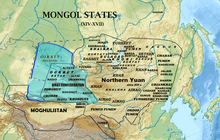
Back Oiratos AN الأويرات Arabic المغول الاويراتيه ARZ Oyratlar Azerbaijani اویراتلار AZB Айраты Byelorussian Ойрати Bulgarian Oirat Catalan Ojrati Czech Oiraten German
This article has multiple issues. Please help improve it or discuss these issues on the talk page. (Learn how and when to remove these messages)
|
 The location of the Four Oirat | |
| Total population | |
|---|---|
| 655,372 | |
| Regions with significant populations | |
(mainly in Xinjiang) | 250,000 (2013 estimate) |
| 205,000 (2010 census) | |
| 183,372 (2010 census) | |
| 12,000 (2018) | |
| Other | 5,000 (2020) |
| Languages | |
| Mainly: Oirat, Russian, other Mongolian languages Regional: Chinese | |
| Religion | |
| Tibetan Buddhism, Mongolian shamanism, Islam[1] | |
| Related ethnic groups | |
| Kalmyks and other Mongol peoples, Tuvans | |
Oirats (/ˈɔɪræt/; Mongolian: Ойрад [ˈɞe̯ɾə̆t]) or Oirds (Mongolian: Ойрд [ˈɞe̯ɾə̆t]; Kalmyk: Өөрд [ˈøːɾə̆t]), formerly known as Eluts and Eleuths (/ɪˈluːt/ or /ɪˈljuːθ/; Chinese: 厄魯特, Èlǔtè),[2][3] are the westernmost group of the Mongols, whose ancestral home is in the Altai region of Siberia, Xinjiang and western Mongolia.
The first documented reference to Elut and Yelut was in the Onginsk "rune" inscriptions dated in the sixth century.[4] Historically, the Oirats were composed of four major tribes: Dzungar (Choros or Olots/Elut/Yelut/Èlǔtè), Torghut, Dörbet and Khoshut.
The political elite of the Rouran and Tobgach empires were YELÜ-T Mongolic speakers. Although these two empires encompassed multilingual populations, the language of diplomacy, trade, and culture was an ÖLÜ (YELÜ) dialect of ancient Mongolic descent.[4] When the Tobgach destroyed the Rouran Empire, the Mongolic-speaking Avar people escaped into the Caspian steppes.[4]
This displacement triggered a series of events. Settling in the Caucasus around 558, the Mongolic Avars intervened in Germanic tribal conflicts, forming alliances such as with the Lombards to overthrow the Gepidae, who were Byzantine allies.[5] Between 550 and 575, they solidified their presence by establishing the Khanate of the Mongolic Avars (6th to 8th century) in the Caspian and Hungarian steppes.[5]
The modern Kalmyks of Kalmykia on the Caspian Sea in southeastern Europe are Oirats.
- ^ Minahan, James B. (10 February 2014). Ethnic Groups of North, East, and Central Asia. Bloomsbury Publishing USA. p. 209. ISBN 978-1-61069-018-8.
- ^ Robert de Vaugondy〈亞洲圖〉 國立臺灣歷史博物館典藏網
- ^ Owen Lattimore, The Desert Road to Turkestan. (For Lattimore, Euleuths are "the great western group of tribes which marks in all probability a primitive racial cleavage" (p. 101 in the ca. 1929 edition). Lattimore further (p. 139 refers to Samuel Couling of The Encyclopaedia Sinica (1917), according to whom the spelling "Eleuth" was due to French missionaries, representing the sound of something like Ölöt. Into Chinese, the same name was transcribed as (Pinyin: Elute; Mongolian: Olot).))
- ^ a b c Bougdaeva, Saglar (2024). "The Yelu Language of War and Peace: A Revised Oirad Translation of the Altai Runic Inscriptions (6th–9th centuries)". Central Asiatic Journal. 66 (1–2): 27–46.
- ^ a b Cite error: The named reference
ref02was invoked but never defined (see the help page).